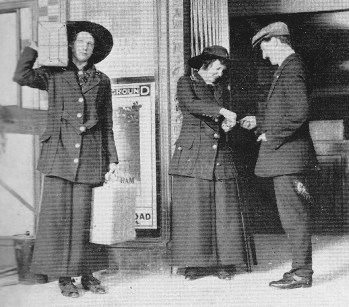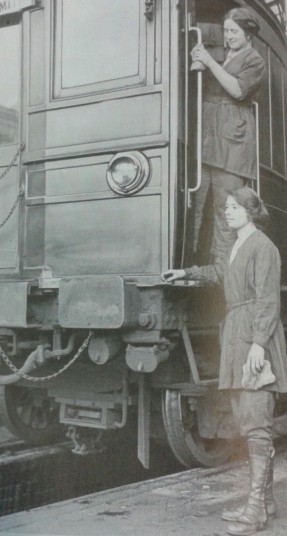February 10, 2014
Titanic : A(nother) History Wardrobe Presentation
So glad to hear our presentation of TITANIC at Bagshaw Museum had the audience enthralled…
Fun and fashion are hardly the first words to come to mind when thinking about The Titanic but Lucy and Meredith of The History Wardrobe brought both to a rather dreary (weatherwise) afternoon at The Bagshaw Museum in Batley on Saturday. Last November I attended Lucy Adlington’s History Wardrobe presentation “Oh my poor nerves!” at The Red House in Gomersal and found I was “hooked”. After that performance I immediately booked for Titanic, thus securing ticket number 1!
The Bagshaw Museum, Batley
In 2012 I felt as if I never wanted to hear the word Titanic again. It seemed to crop up everywhere and on a visit to Belfast that June I even went to visit the Museum of the same name.
The Titanic Experience in Belfast
Titanic Postcards
Titanic Keyrings
For 15 years now Lucy has presented history, and particularly women’s history, through women’s fashions. Visit her…
View original post 446 more words
February 5, 2014
Railway Women in WW1
“Porters in skirts!” gasped an article in the Daily Mirror of April 1915. This remarkable sight left a male porter  staring “in helpless astonishment” at women actually lifting heavy items of luggage.
staring “in helpless astonishment” at women actually lifting heavy items of luggage.
Women had been employed on Britain’s railways from the first years of Queen Victoria’s reign, but in limited numbers and with a low profile. By the start of the Great War there were 18,200 women in transport generally. Fours years later this number had increased to an impressive 117,000 women, mainly to fill the gaps left by large numbers of men leaving to join the services. In 1914 there was a grand total of 3 female porters. By 1918 there were 10,000.
At first women were barely encouraged to take an active role in the war effort. From August 1914 they were told to nurse if capable, or knit if not. By 1915, under the leadership of militant suffragette Mrs Pankhurst, a London march saw 30,000 women declaring loudly “We demand the right to serve!” Once women were able to join the National Register for employment in 1915 87,000 women applied for the meagre 2332 jobs listed.
Women were no strangers to the world of work. At the outbreak of war there were 5.9million females gainfully employed in Britain – not to mention all the unpaid labour of child-rearing, household management and charitable endeavours. Much of their work was in so-called ‘female’ areas – cleaning and communication – and so the greedy need for workers on the railways initially pushed women into ‘traditional’ roles such as carriage-cleaners and telephone operators. However, such was the demand women had to be accepted into ‘male’ roles: engine-cleaners, workshop labourers, porters, signal operators, crossing gatekeepers and even station mistresses. The rail network had to be kept operational.
 Company and public responses were mixed. When even the male domain of the signal box was invaded, the Railway Review of the National Union of Railwaymen declared, “lever-pulling is not good for women’s delicate constitutions” but the Railway Gazette was adamant that women were “capable of safely and satisfactorily meeting all the emergencies that the signal box creates.”
Company and public responses were mixed. When even the male domain of the signal box was invaded, the Railway Review of the National Union of Railwaymen declared, “lever-pulling is not good for women’s delicate constitutions” but the Railway Gazette was adamant that women were “capable of safely and satisfactorily meeting all the emergencies that the signal box creates.”
There was praise for women’s enthusiastic adoption of work outside their normal sphere of experience from the NER magazine: “…considering the fact that they are entirely strange to railway work, every credit is due to them for the manner in which they are tackling the various duties required with a view to becoming speedily efficient.”
Women were barred from working as drivers or firemen on the locomotives, partly because the training period was too long for speedy employment, and partly because of a men-only protectionism. This blinkered approach to gender at work also meant that even if women did exactly equal work as the men, they did not receive equal pay, despite Union concerns that this would undercut male workers. Miss Edwards, a GWR motor-lorry driver earned 46s 6d while her male colleagues received 66s. She observed – “I think I am entitled to the same wage as men.” Arguments that men were ‘breadwinners’ held no sway with women who had dependents, and who faced exactly the same bills for food, fuel and rent as the men. In some instances women only earned 1/3 of the male wage.
New work meant new clothes. Donning a uniform gave women an entry into a male world of discipline, group identity and company  pride. Some companies provided jackets and just-below-the-knee length skirts for guards and ticket-collectors. More heavy-duty work required purely practical clothes, and the shocking adoption of men’s trousers. The 40 trouser-wearing women employed in the engine-sheds at York were said to cause “no small stir as they take their after-dinner walk.” Sheffield workers had blue trouser overalls, described as “natty and workmanlike.” From 1915 there was a noticeable ‘splash’ in the press of photo montages showing women’s very public achievements in new roles.
pride. Some companies provided jackets and just-below-the-knee length skirts for guards and ticket-collectors. More heavy-duty work required purely practical clothes, and the shocking adoption of men’s trousers. The 40 trouser-wearing women employed in the engine-sheds at York were said to cause “no small stir as they take their after-dinner walk.” Sheffield workers had blue trouser overalls, described as “natty and workmanlike.” From 1915 there was a noticeable ‘splash’ in the press of photo montages showing women’s very public achievements in new roles.
It couldn’t last. Protection of men’s railway work was enshrined in law in 1919, with the Restoration of Pre-War Practices Act. The majority of women who’d been employed as temporary workers had to quit to make room for men returning from war. Badly paid or unpaid domestic work was to be their lot once more. Of those women remaining, most were in clerical and communications roles, which came to be seen as a female vocation. The argument that the granting of the right to vote to women was a ‘reward’ for war work is weak. This ‘reward’ was only for women over 30, who owned their own house or who were married to a householder. It did not take into account the long, hard graft of girls as young as 15.
But there could be no return to the pre-war myth of female incapability. One female railway clerk wrote that women could no longer be considered “of secondary importance.” By the time World War Two loomed and women were once again needed for all spheres of work on the Home Front, they had already more than proved the lie of the claim that they were “not fit for the strain.”
Sources: Rob Langham, The North Eastern Railway in the First World War Fonthill Media 2013; A.W. Kirkaldy, British Labour Replacement and Conciliation 1914-21, Rosa Matheson, The Fair Sex – Women and the Great Western Railway The History Press 2007; Helena Wojtczak, Railwaywomen – Exploitation, Betrayal and Triumph in the Workplace Hastings Press 2005; Lucy Adlington, Great War Fashion – Tales from the History Wardrobe The History Press 2013.
With thanks to: Bob Gwynne at the National Railway Museum and Leona White-Hannant at Darlington Head of Steam Museum




